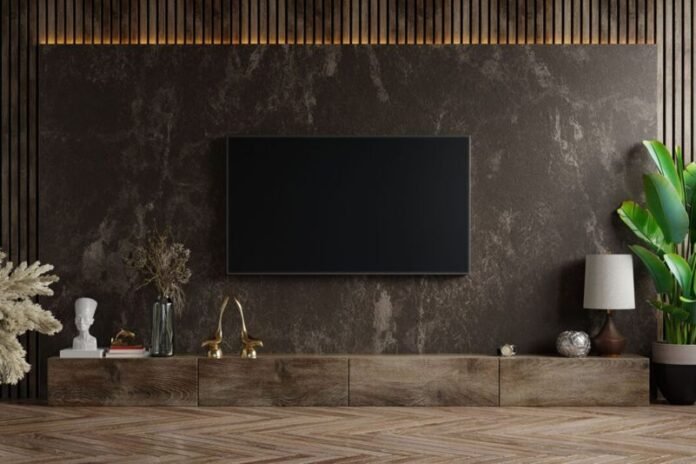HOW TO POSITION A TV IN THE INTERIOR
The TV in the interior is a large black rectangle and when turned off, it is a kind of black hole. You can do nothing with this blackness, but it will be better and more interesting to somehow beat it and thereby neutralize it. And how you can arrange the TV in the interior, I want to talk in this article.
When choosing a TV, you should pay attention to its size: too small a TV will get lost in space, and too large will overload it, and you can’t always hang one on the wall.
“TV wall decoration”
The wall on which the TV is hung can be finished with something, for example, plain wallpaper or painted, with panels or even a parquet board, lined with stone tiles, etc.
“Placement of the TV on/in furniture “
The next option is to use various designs – niches and ledges.
You can order special furniture for video equipment. Or even hide the TV from prying eyes and “pull out” it only when necessary. Modern systems make it easy to do this.
“TV screen as a picture “
Flat TV looks like a picture. To enhance this effect, designers frame the TV with a frame – it can be a wooden frame or a frame made of polyurethane moldings, hang around the picture and there will be an art gallery.
The example below is my favorite. Since the black rectangle of the TV is surrounded on all sides by rectangles of pictures of different sizes, it does not attract much attention to itself and does not “break” the interior.
AT WHAT DISTANCE TO PLACE THE TV
The distance to the screen should be at least 3-4 diagonals of the screen (I wrote more about this HERE). Well, if we are talking about a plasma TV. LCD TVs can also be viewed from a distance of 2 diagonals. And from the floor, the most comfortable zone is at eye level.
When buying a TV, plasma, or LCD panel, each person, first of all, looks at the size (diagonal) and the price of the device. And at the same time, he forgets about the size of his room in which this TV will stand.
Many people think that if the screen is large, then the “presence effect” while watching a movie will be stronger. This is not entirely true. If the budget allows you to buy a TV with a large diagonal, and the room is small, then this will lead to the fact that during dynamic scenes when watching the next blockbuster, a person will have to constantly move his eyes and head from one corner of the screen to another, because the angle of view will not be enough to freely observe what is happening on the screen.
Pay attention to how the hall in some cinemas is filled – first tickets to the middle of the hall are sold out. People intuitively feel from what place they will be able to cover the entire screen without tension and additional movements.
After filling the middle, tickets are bought for the back rows. Then to the side seats. And only in the very last turn, the first row is filled! It is most inconvenient to look from it – you need to lift your head up and constantly move your eyes to cover the whole picture.
Therefore, I want to offer you an infographic that can be useful if you need to choose the size of the plasma or decide how far from the TV to put the sofa. The distance is in meters for a 16:9 aspect ratio screen. The screen size is indicated in inches (usually indicated on the box with the device or on its back cover).
You can place a TV in almost any room of the apartment, but the main thing is that it will be convenient to watch it from all points in the room. Make sure that the sun’s rays do not fall on the screen, otherwise, the glare will spoil the whole picture. It is also not recommended to place TVs near any heating devices.
“Mounting the TV on the wall “
Mounting should be done responsibly. Not every wall can support a TV. Experts do not recommend hanging a TV weighing more than 30-35 kg on a weak plasterboard wall. Well, if you really want to, you can strengthen the TV wall by hemming it with a thick plywood sheet or build a small drywall ledge with a reinforced wall. You cannot install the TV in a closed space – the air must circulate freely through the ventilation holes of the TV, that is, small niches are not suitable for this.
If you really want to mount a TV in a tight niche, buy special built-in LCD panels. If you still decide to hang the TV on the wall and not put it on the cabinet, then use a special bracket for this. It is sold in any store along with a TV. Brackets are different: they differ in the type of TVs installed on them (plasma or LCD) and in the weight of the equipment. There are brackets with rigid fixation (fixed), brackets with the ability to adjust the tilt
Part of the problem that arises when placing a TV in an interior is the question of where to put the wires. They can’t just hang around in plain sight. Alternatively, you can make a cable channel in the wall if the wall is plasterboard. Two holes are made: behind the TV and below, closer to the plinth. You can, of course, make a socket right behind the TV, but it is advisable to do this only if the TV is extended from the wall or mounted on a movable bracket.
You can get by with small sacrifices and not ditch the wall, especially if it is concrete. Just hide the cables and wires in a cable channel (box) over the wall, or make a drywall construction.
Which option to choose is up to you. But it’s better to beat the TV somehow, not to leave it just like that. This will add harmony to the interior.
HOW HIGH TO MOUNT YOUR TV ON THE WALL
Figuring out the ideal placement for your wall-mounted TV helps optimize viewing. The recommended height and distance from seating varies based on the size of your television. Follow these mounting guidelines for a perfectly positioned TV.
For 32-55 inch TVs:
- Mount the TV so the center sits approximately 56-60 inches off the floor. This positions a 42-inch TV with the center at about 58 inches high.
- Place the sofa or primary seating 8-11 feet away from the TV, depending on available space. For a 55-inch TV, sit approximately 9 feet away.
For 60-65 inch TVs:
- Mount the TV with the center point at about 63 inches from the floor. This puts a 65-inch screen with the center at 65 inches high.
- Sit approximately 9-12 feet away. Leave 11 feet between a 65-inch TV and the primary seating area.
For 70-85 inch TVs:
- Mount massive screens with the center point around 67-72 inches from the floor. A 80-inch TV should hang with its center at 70 inches high.
- Sit 11-16 feet away. Leave 14 feet between an 85-inch TV and the sofa for ideal viewing.
Regardless of size, always mount the television at eye level while seated for optimal comfort. Follow the manufacturer’s instructions to ensure the mount can support the TV’s weight. With these size-specific guidelines, you can perfectly customize the height and distance for your new wall-mounted TV.
CAN YOU MOUNT A TV ABOVE A FIREPLACE OR RADIATOR?
When looking for a spot to mount your new TV, you may wonder:
Can I mount a tv on the wall above a fireplace?
Mounting a TV above a fireplace is possible but not always safe. The intense heat from a fire can damage TV components and cause issues like melted plastics and board warping. This risk depends on the exact mounting height and how often you use the fireplace.
If you do mount above a fireplace, position the TV at least 12 inches above the mantel to allow proper ventilation and use a mantel TV heat shield. Also install a TV lift mechanism that allows you to raise the TV safely out of the way when using the fireplace.
Is it safe to put a tv on the wall above a radiator?
Mounting a TV on the wall above a radiator is generally not recommended. Like fireplaces, radiators release a lot of ambient heat that can potentially damage TV sets over time. The electronics are sensitive to excess heat. Mounting too close also blocks proper air flow from the radiator into the room. If you must mount over a radiator, place the base of the TV at least 3 feet above the unit. But keep in mind this heat exposure may shorten the life of your TV.
The best approach is to mount your TV on a safe, dry, climate-controlled wall without exposure to heat sources or moisture. Take precautions if forced to mount over a fireplace or radiator to minimize the risk of long-term TV damage. Consider speaking with a professional installer for guidance mounting over awkward areas.






